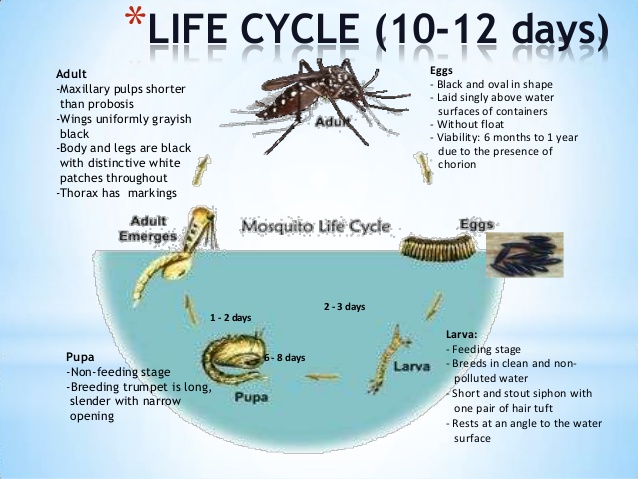About Dengue Fever
Dengue Fever and Dengue Haemorrhagic Fever (a more severe form) are the most common mosquito-borne viral diseases in the world.
Dengue Fever is an illness caused by infection with a virus transmitted by the Aedes mosquito. There are four serotypes of this virus (DEN-1, DEN-2, DEN-3 and DEN-4) which can infect you.
Dengue Fever is spread though the bite of the Aedes Mosquito. There is no drug treatment for dengue.
To prevent dengue fever, you must prevent the breeding of its carrier, the Aedes mosquitoes. Aedes mosquitoes are identified by the black and white stripes on their bodies. You can get rid of the Aedes mosquito by frequently checking and removing stagnant water in your home.
Life Cycle of an Aedes Mosquito

Under optimal conditions, the egg of an Aedes mosquito can hatch into a larva in less than a day. The larva then takes about four days to develop into a pupa, from which an adult mosquito will emerge after two days. Three days after the mosquito has bitten a person and taken in blood, it will lay eggs, and the cycle begins again.
Did you know?
- Only the female Aedes mosquito bites as it needs the protein in blood to develop its eggs.
- The mosquito becomes infective approximately seven days after it has bitten a person carrying the virus. This is the extrinsic incubation period, during which time the virus replicates in the mosquito and reaches the salivary glands.
- Peak biting is at dawn and dusk.
- The average lifespan of an Aedes mosquito in Nature is two weeks.
- The mosquito can lay eggs about three times in its lifetime, and about 100 eggs are produced each time.
- The eggs can lie dormant in dry conditions for up to about nine months, after which they can hatch if exposed to favourable conditions, i.e. water and food.
